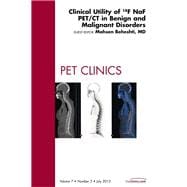
Note: Supplemental materials are not guaranteed with Rental or Used book purchases.
Purchase Benefits
Looking to rent a book? Rent Clinical Utility of 18F NaF PET/CT in Benign and Malignant Disorders [ISBN: 9781455748860] for the semester, quarter, and short term or search our site for other textbooks by Beheshti, Mohsen, M.D.. Renting a textbook can save you up to 90% from the cost of buying.
| Preface | p. ix |
| 18F NaF PET/CT Versus Conventional Bone Scanning in the Assessment of Benign Bone Disease | p. 249 |
| Nuclear physicians in many centers nowadays have the choice of using different nuclear bone-imaging modalities. 18F-labeled sodium fluoride (NaF) PET with computed tomography (PET/CT) is a promising tool for the evaluation of benign bone disease. The indications for NaF PET/CT in clinical practice are probably the same as those established for 99mTc-labeled methylene diphosphonate bone scintigraphy and single-photon emission computed tomography (SPECT)/CT. At present only preliminary data, often with a limited number of patients and lacking comparison with 99mTc-MDP SPECT/CT, are available. This article reviews the available literature and summarizes the authors' experience with NaF PET/CT in benign bone disease. | |
| 18F NaF PET/CT in the Assessment of Malignant Bone Disease | p. 263 |
| Diagnostic imaging plays a major role in the evaluation of patients with malignant bone disease. 18F-Labeled sodium fluoride (18F NaF) is a positron-emitting radiopharmaceutical with desirable characteristics (rapid blood clearance and bone uptake) for high-quality functional imaging of the skeleton. In addition to higher sensitivity and specificity, 18F NaF PET combined with computed tomography (PET/CT) allows for shorter imaging time, thus improving patients convenience and benefiting the overall workflow of the imaging facility. Although as yet no robust evidence-based data exist, this article summarizes the published data currently available on the role of 18F NaF PET/CT in the assessment of malignant bone disease. | |
| Quantitative PET Imaging Using 18F Sodium Fluoride in the Assessment of Metabolic Bone Diseases and the Monitoring of Their Response to Therapy | p. 275 |
| Studies of bone remodeling using bone biopsy and biochemical markers of bone turnover measured in serum and urine are important for investigating how new treatments for osteoporosis affect bone metabolism. Positron emission tomography with 18F sodium fluoride (18F NaF PET) for studying bone metabolism complements these conventional methods. Unlike biochemical markers, which measure the integrated response to treatment across the whole skeleton, 18F NaF PET can distinguish changes occurring at sites of clinically important osteoporotic fractures. Future studies using 18F NaF PET may illuminate current clinical problems, such as the possible association between long-term treatment with bisphosphonates and atypical fractures of the femur. | |
| Pediatric Bone Scanning: Clinical Indication of 18F NaF PET/CT | p. 293 |
| Skeletal imaging of children with fluorine-18 (18F) NaF harnesses the superior imaging characteristics of positron emission tomography (PET) and the improved biodistribution of the fluoride tracer compared with standard nuclear techniques, resulting in excellent quality images. Bone malignancy in children is less common than in adults, and the evaluation of benign skeletal disorders represents a larger fraction of indications in the pediatric versus adult population. 18F NaF PET imaging has been successfully applied to various benign disorders, particularly trauma and sports medicine applications. | |
| 18F NàF PET/CT in the Assessment of Metastatic Bone Disease: Comparison with Specific PET Tracers | p. 303 |
| The skeletal system is the third most common site of metastases after the lungs and liver, and 80% of all reported metastatic bone disease is in patients with breast and prostate cancer. At present there are an unprecedented number of novel molecular imaging agents potentially available for the assessment of bone metastases in different cancer. This review assesses the role of PET in the imaging of skeletal metastases, focusing on the specific PET tracers (fluorodeoxyglucose, choline derivatives, and so forth), in comparison with 18F NaF as a nonspecific bone-seeking PET agent. | |
| 18F NaF PET/CT and Conventional Bone Scanning in Routine Clinical Practice: Comparative Analysis of Tracers, Clinical Acquisition Protocols, and Performance Indices | p. 315 |
| Conventional planar and SPECT bone scintigraphy has long been used and familiarity with this tracer and imaging technique is excellent. 18F NaF PET/CT represents an alternative tracer and imaging modality for the assessment of the skeleton, with the potential to become the gold standard in functional bone imaging. This article com pares the pharmacokinetics, protocols, clinical performance, and cost-effectiveness of the 2 modalities. Technological advances and future directions of both modalities are also discussed. | |
| Value of 18F NaF PET/CT in the Detection and Global Quantification of Cardiovascular Molecular Calcification as Part of the Atherosclerotic Process | p. 329 |
| Detection of early ongoing cardiovascular molecular calcification and its quantification through 18F-labeled sodium fluoride(18F NaF) PET/computed tomography (CT) imaging has been a recent addition to the diagnostic armamentarium of molecular imaging for the atherosclerotic process. At present, visual detection of molecular calcification as well as its regional quantification on (18F NaF) PET/CT are suboptimal, mainly because of the very low degree of uptake of this radiotracer in the heart and major vessels, and hence subject to the partial volume effect. Calculation of car diovascular 18F NaF uptake in the heart and arterial wall using automated software is an innovative approach. | |
| Index | p. 341 |
| Table of Contents provided by Ingram. All Rights Reserved. |
The New copy of this book will include any supplemental materials advertised. Please check the title of the book to determine if it should include any access cards, study guides, lab manuals, CDs, etc.
The Used, Rental and eBook copies of this book are not guaranteed to include any supplemental materials. Typically, only the book itself is included. This is true even if the title states it includes any access cards, study guides, lab manuals, CDs, etc.